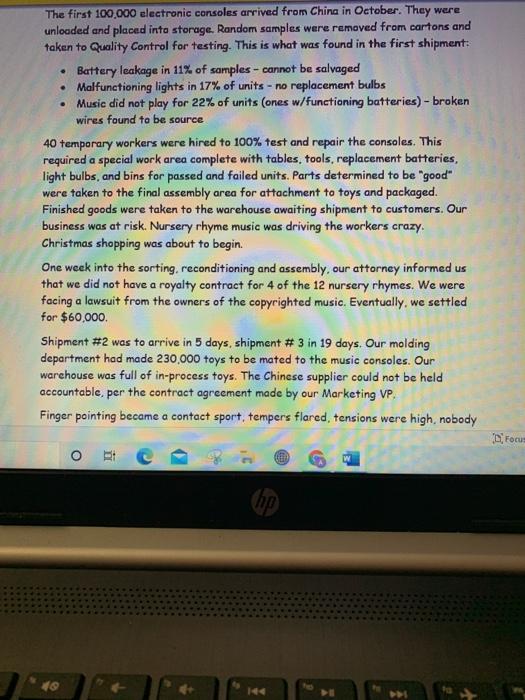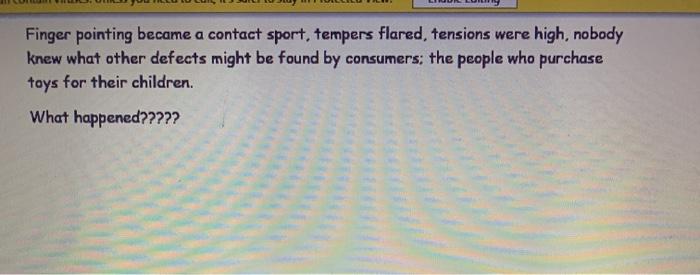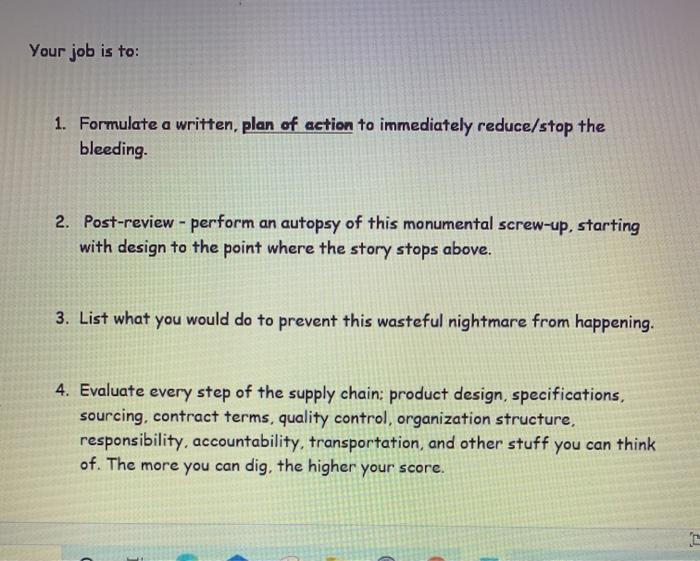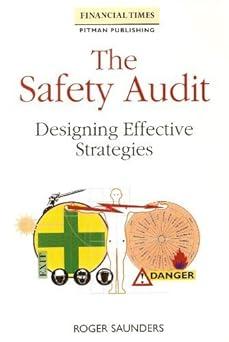A long, long time age in a toy factory far away Electronics were taking over the tay market with music and flashing lights. Our ride-on, push and sit-on toys did not have electronics, sales were dropping. A decision was made by Marketing, supported by the company's President, to add battery powered electronic consoles to our highest sales volume toys. We did not have the capacity to make the electronic consoles. It would require months and big bucks to add capacity. Marketing pressured Purchasing to source the electronics from China. Purchased consoles would be attached to toys at our US factory located in Booneville, AR. Up to that point in our history, we had not sourced anything from China. Our Quality Department protested, but was overruled. Marketing had the ear of the President, he had previously worked as VP Marketing and replaced himself with his favorite suck-up. Marketing, not Purchasing, sent a representative to China to find a source for consoles. A deal was made to manufacture and ship 300,000 electronic consoles @ a price of $3.47, cach, FOB Shanghai. Three (3) shipments of 100,000 units would be shipped via ocean going container ships, two weeks apart. Customer and consumer surveys were receptive to electronics being added to our high quality toys. Each console played 12 nursery rhymes and multi-colored lights flashed when music played. So far, not a bad plan, right? Focus O !! w 8 & C The first 100.000 electronic consoles arrived from China in October. They were unloaded and placed inta storage. Random samples were removed from cartons and taken to Quality Control for testing. This is what was found in the first shipment: Battery leakage in 11% of samples - cannot be salvaged Malfunctioning lights in 17% of units - no replacement bulbs Music did not play for 22% of units (ones w/functioning batteries) - broken wires found to be source 40 temporary workers were hired to 100% test and repair the consoles. This required a special work area complete with tables, tools, replacement batteries, light bulbs, and bins for passed and failed units. Parts determined to be "good" were taken to the final assembly area for attachment to toys and packaged. Finished goods were taken to the warehouse awaiting shipment to customers. Our business was at risk. Nursery rhyme music was driving the workers crazy Christmas shopping was about to begin. One week into the sorting, reconditioning and assembly, our attorney informed us that we did not have a royalty contract for 4 of the 12 nursery rhymes. We were facing a lawsuit from the owners of the copyrighted music. Eventually, we settled for $60,000 Shipment #2 was to arrive in 5 days, shipment #3 in 19 days. Our molding department had made 230,000 toys to be mated to the music consoles. Our warehouse was full of in-process toys. The Chinese supplier could not be held accountable, per the contract agreement made by our Marketing VP. Finger pointing became a contact sport, tempers flared, tensions were high, nobody Focu O 1 Finger pointing became a contact sport, tempers flared, tensions were high, nobody knew what other defects might be found by consumers; the people who purchase toys for their children. What happened????? Your job is to: 1. Formulate a written, plan of action to immediately reduce/stop the bleeding. 2. Post-review - perform an autopsy of this monumental screw-up, starting with design to the point where the story stops above. 3. List what you would do to prevent this wasteful nightmare from happening. 4. Evaluate every step of the supply chain: product design, specifications, sourcing, contract terms, quality control, organization structure, responsibility, accountability, transportation, and other stuff you can think of. The more you can dig, the higher your score










